Graphic Template Establishment and Productivity Evaluation Model of Post-Fracturing Based on the Fluctuation Pattern of G-Function Curve
Abstract
:1. Introduction
2. Materials and Methods
3. Plate and Model Building
3.1. Establishment of the G-Functional Graphic Template
3.2. G-Function Yield Evaluation Model
4. Discussion
4.1. G-Function Graphic Template Validation
4.2. Validation of the G-Function Yield Evaluation Model
5. Conclusions
- (1)
- Based on the theoretical basis of the G-function, the G-function graphic template and the corresponding fracture pattern were proposed by analyzing the corresponding G-function curve patterns of different blocks in combination with production, and verified according to high- and low-production wells with high accuracy, which can effectively provide feedback on the field fracturing effect and guide the subsequent fracturing construction.
- (2)
- Based on the morphological characteristics of the G-function curve, a G-function production evaluation mathematical model based on four indicators is proposed and validated using high- and low-producing sections of shale gas wells with production profile data. From the validation of the production capacity model, it can be seen that the average value of the production evaluation Y of the high-producing section is higher than that of the low producing section by 75.9%, which is much larger than that of the low-producing section, which shows the accuracy and adaptability of this model.
- (3)
- The work intensity at the fracturing site is high and the construction time is long, so it is difficult to have time to evaluate the fracturing effect after completing a section of fracturing construction and to continue the fracturing operation in the next section. Therefore, the author proposes a G-function plate for evaluating the post-fracturing effect, according to which the G-function curve can be quickly matched with the plate after finishing the drawing of the G-function curve to judge the fracture pattern formed after fracturing the section, which is convenient for guiding the efficient construction of fracturing work.
Author Contributions
Funding
Institutional Review Board Statement
Informed Consent Statement
Data Availability Statement
Conflicts of Interest
References
- Dai, J.; Qin, S.; Hu, G.; Ni, Y.; Gan, L.; Huang, S.; Hong, F. Significant progress of natural gas exploration and development in New China over the past 70 years. Pet. Explor. Dev. 2019, 46, 1037–1046. [Google Scholar] [CrossRef]
- Ma, Y.; Cai, X.; Zhao, P. Theoretical understanding and practice of shale gas exploration and development in China. Pet. Explor. Dev. 2018, 45, 561–574. [Google Scholar] [CrossRef]
- Ma, X. Theory and practice of unconventional natural gas “limit utilization” development. Pet. Explor. Dev. 2021, 48, 326–336. [Google Scholar] [CrossRef]
- Zhou, X.; Yong, R.; Fan, Y.; Zeng, B.; Song, Y.; Guo, X.; Zhou, N.; Duan, X.; Zhu, Z. Influence of natural fractures on fracturing of shale gas horizontal wells and process adjustment. China Pet. Explor. 2020, 25, 94–104. [Google Scholar]
- Zhao, C.; Wang, H.; Guo, W.; Zhang, W.; Fan, Q.; Tian, J.; Chen, H.; Tang, D.; Zhao, J. Shale pneumatic fracture microseismic monitoring technology and its application to Platform X in the Weiyuan area of the Sichuan Basin. Adv. Geophys. 2022, 37, 2089–2096. [Google Scholar]
- Zhao, C.; Jia, Z.; Tian, J.; Gao, R.; Zhang, W.; Zhao, J. Evaluation of fracturing effect based on in-well microseismic monitoring method—An example of Y22 well in Jilin prospect. Rocky Oil Gas Reserv. 2020, 32, 161–168. [Google Scholar]
- Zhao, C.; Zhou, Z.; Tian, J.; Li, R.C.; Chang, D.; Zhang, W.; Feng, B.; Li, J. Study on the application of microseismic monitoring in fractured wells of sparse sandstone gas reservoirs: An example from Shibei gas field. Adv. Geophys. 2020, 35, 1919–1925. [Google Scholar]
- Wang, G.; Xiao, Y.; Zhao, H.; Wang, Y.; Chen, Y. Application of microseismic monitoring technology in repeated fracturing of shale gas horizontal wells. Geol. Explor. 2019, 55, 1336–1342. [Google Scholar]
- Ren, L.; Su, Y.L.; Xu, C.; Meng, F.K.; Zhan, S.Y. Research progress of capacity prediction methods for volumetric fractured horizontal wells in unconventional reservoirs. In Proceedings of the 2015 International Conference on Oil and Gas Field Exploration and Development, Xi’an, China, 20–21 September 2015; pp. 785–798. [Google Scholar]
- Rahman, M.K.; Rahman, M.M.; Joarder, A.H. Analytical Production Modeling for Hydraulically Fractured Gas Reservoirs. Liq. Fuels Technol. 2007, 25, 683–704. [Google Scholar] [CrossRef]
- Rahman, M.M.; Rahman, M.K. Optimizing Hydraulic Fracture to Manage Sand Production by Predicting Critical Drawdown Pressure in Gas Well. J. Energy Resour. Technol. 2012, 134, 013101. [Google Scholar] [CrossRef]
- Zou, C.; Zhao, Q.; Dong, D.; Yang, Z.; Qiu, Z.; Liang, F.; Wang, N.; Huang, Y.; Duan, A.; Zhang, Q.; et al. Geological characteristics, main challenges and future prospect of shale gas. Nat. Gas Geosci. 2017, 28, 1781–1796. [Google Scholar] [CrossRef]
- Nolte, K.G. Determination of fracture parameters from fracturing pressure decline. In Proceedings of the SPE Annual Technical Conference and Exhibition, Las Vegas, NV, USA, 23–26 September 1979. [Google Scholar]
- Nolte, K.G.; Maniere, J.L.; Owens, K.A. After-closure analysis of frac-ture calibration tests. In Proceedings of the SPE Annual Technical Conference and Exhibition, San Antonio, TX, USA, 5–8 October 1997. [Google Scholar]
- Barree, R.D.; Mukherjee, H. Determination of Pressure Dependent Leakoff and Its Effect on Fracture Geometry. In Proceedings of the SPE Annual Technical Conference and Exhibition, Denver, CO, USA, 6–9 October 1996. [Google Scholar]
- Meyer, B.R.; Jocat, R.H. Implementation of fracture calibration equations for pressure dependent leakoff. In Proceedings of the SPE/AAPG Western Regional Meeting, Long Beach, CA, USA, 19–22 June 2000. [Google Scholar]
- Cipolla, C.L.; Warpinski, N.R.; Mayerhofer, M.J. Hydraulic Fracture Complexity: Diagnosis, Remediation, and Exploitation. In Proceedings of the SPE Asia Pacific Oil and Gas Conference and Exhibition, Perth, Australia, 20–22 October 2008. [Google Scholar]
- Syfan, F.E.; Newman, S.C.; Meyer, B.R.; Behrendt, D.M. Case History: G-function analysis proves beneficial in barnett shale application. In Proceedings of the SPE Annual Technical Conference and Exhibition, Anaheim, CA, USA, 11–14 November 2007. [Google Scholar]
- Rahman, M.M.; Rahman, M.K.; Rahman, S.S. Multicriteria Hydraulic Fracturing Optimization for Reservoir Stimulation. Pet. Sci. Technol. 2003, 21, 1721–1758. [Google Scholar] [CrossRef]
- Liu, H.; Gao, Y.; Zheng, L.; Zou, H. Fracturing Net Pressure Diagnoses Modeling for Volcanic Reservoir. In Proceedings of the SPE Asia Pacific Oil and Gas Conference and Exhibition, Perth, Australia, 22–24 October 2012. [Google Scholar]
- Wang, W.; Zhang, S.; Wang, L.; Zhang, F. Quantitative diagnosis of fracture complexity in bare-hole horizontal wells fractured in volcanic reservoirs. Nat. Gas Ind. 2015, 35, 46–51. [Google Scholar]
- Zhang, Y.P.; Liu, H. Diagnosis and treatment control of difficult fracturing points in volcanic gas reservoirs. Nat. Gas Ind. 2009, 29, 53–55+143. [Google Scholar]
- Zhao, W.; Zhang, S.; Sun, Z.; Zhao, Y.; Yang, Y. Research on post-pressure fracture complexity assessment based on G-function curve analysis. Sci. Technol. Eng. 2016, 16, 29–33+45. [Google Scholar]
- Zhang, C.; Liu, L.; Liu, Q. Research and application of fracturing technology in Songnan volcanic gas reservoir. Drill. Prod. Technol. 2015, 38, 51–54+3. [Google Scholar]
- Liu, G.; Ehlig-Economides, C. Comprehensive Global Model for Before Closure Analysis of an Injection Falloff Fracture Calibration Test. In Proceedings of the SPE Annual Technical Conference and Exhibition, Houston, TX, USA, 28–30 September 2015. [Google Scholar]
- Xiao, Y.; Liu, S.; He, Y.; Li, Z.; Wang, J.; Yang, J.; Ma, Z. Evaluation method of fracture complexity of fracture network fracturing in fractured gas reservoirs of dense sandstone. Spec. Oil Gas Reserv. 2022, 29, 157–163. [Google Scholar]
- Carter, H.W.; Norton, H.W.; Dungan, G.H. Wheat and Cheat1. Agron. J. 1957, 49, 261–267. [Google Scholar] [CrossRef]
- Liu, G.; Ehlig-Economides, C. Interpretation methodology for fracture calibration test before-closure analysis of normal and abnormal leakoff mechanisms. In Proceedings of the SPE Hydraulic Fracturing Technology Conference, The Woodlands, TX, USA, 9–11 February 2016. [Google Scholar]
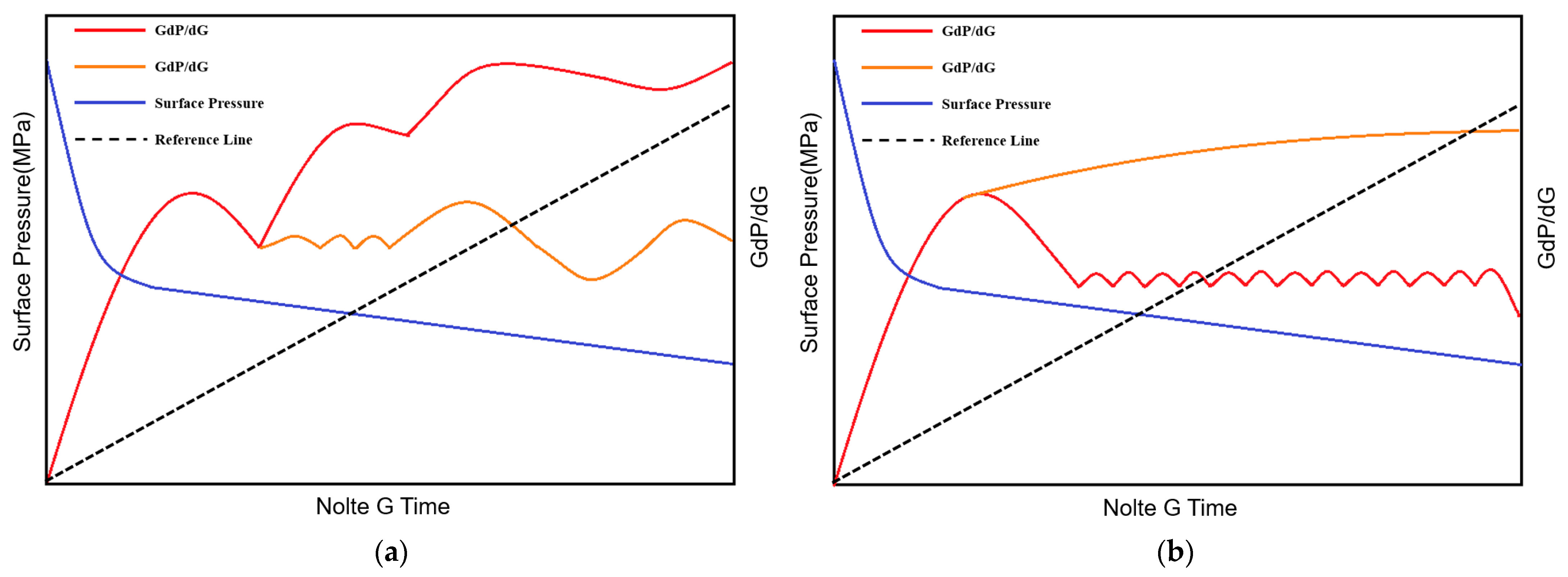
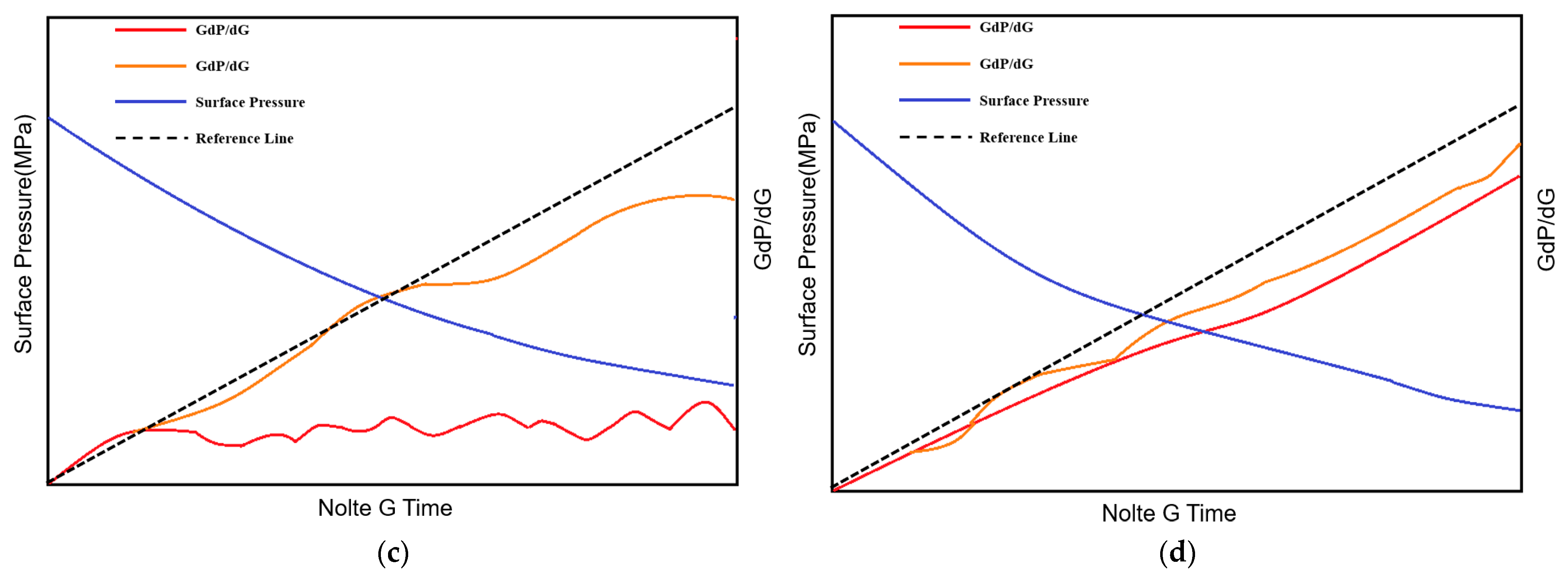




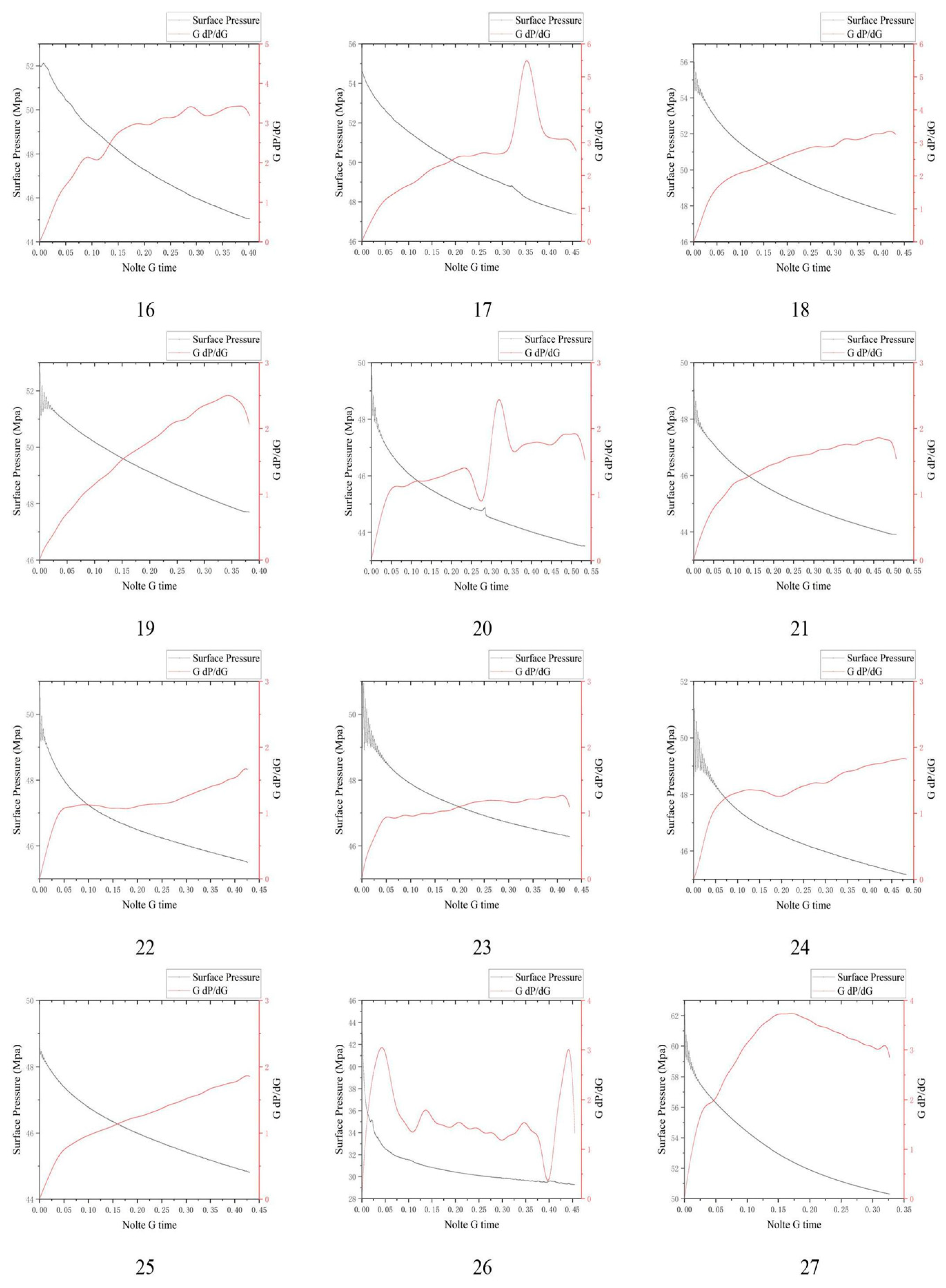
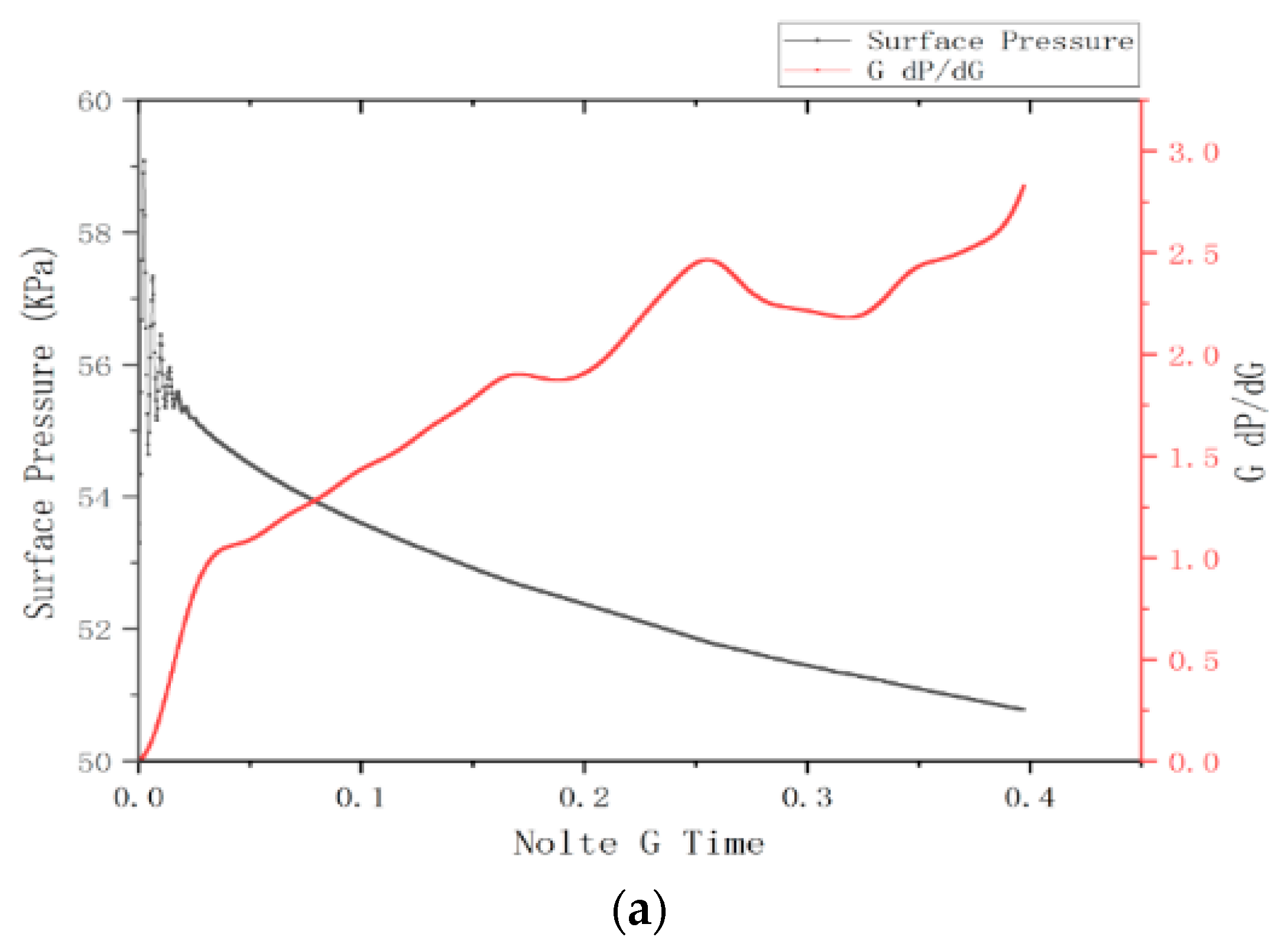
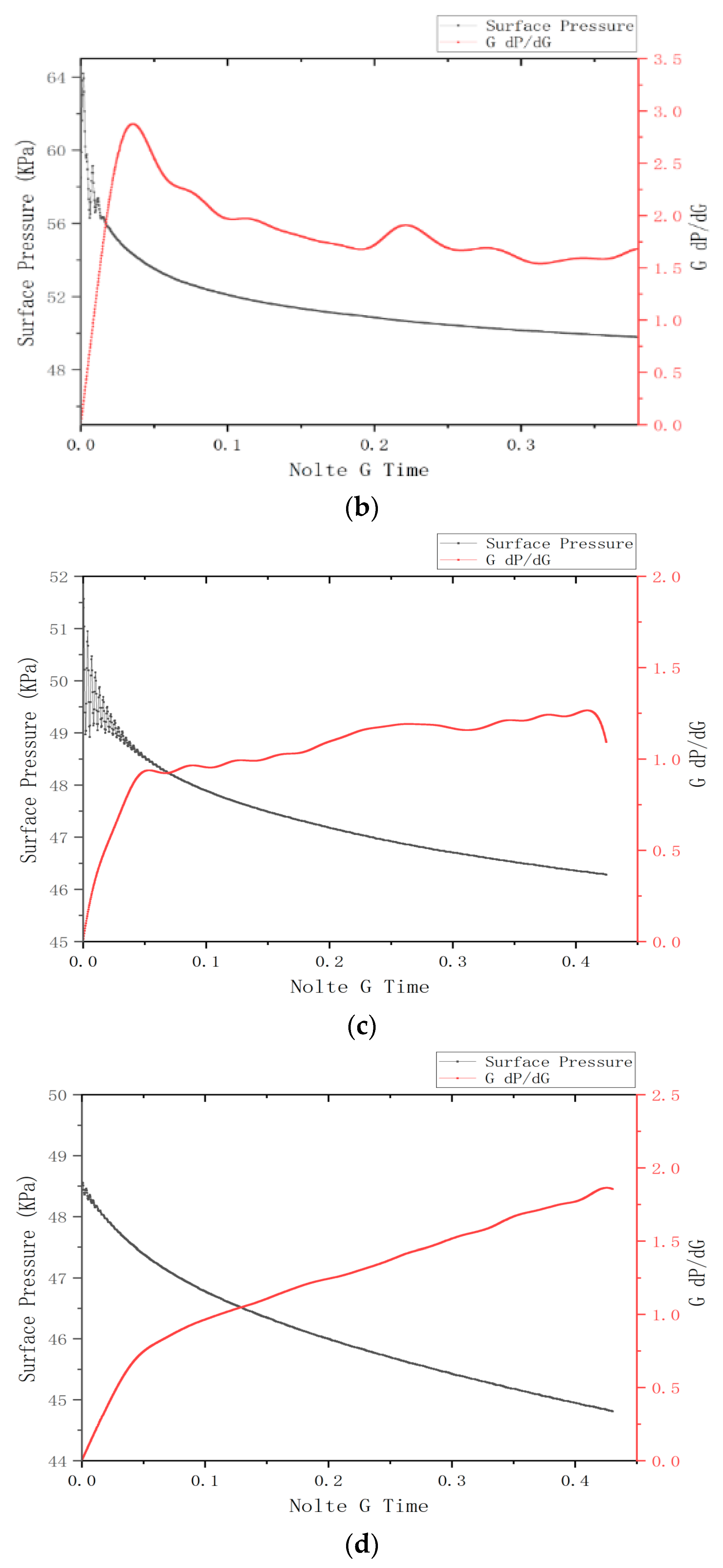

| Evaluating Indicator | Interval Score | ||||
|---|---|---|---|---|---|
| 0 | 0.25 | 0.5 | 0.75 | 1 | |
| k | <15 | 15 ≤ k < 30 | 30 ≤ k < 45 | 45 ≤ k < 60 | ≥60 |
| VΔPt | <10 | 10 ≤ VΔPt < 20 | 20 ≤ VΔPt < 30 | 30 ≤ VΔPt < 40 | ≥40 |
| D | <4 | 4 ≤ D < 6 | 6 ≤ D < 8 | 8 ≤ D < 10 | ≥10 |
| S | <0.2 | 0.2 ≤ S < 0.3 | 0.3 ≤ S < 0.4 | 0.4 ≤ S < 0.5 | ≥0.5 |
| Block | Serial Number | Well Number | Young’s Modulus (GPa) | Poisson Ratio | Testing Production (104 m3) | Daily Gas Production (m3) | Accumulated Production (104 m3) |
|---|---|---|---|---|---|---|---|
| I | 1 | A1 | 37.4 | 0.23 | 14.36 | 10,862 | 2716.9 |
| 2 | A2 | 38.38 | 0.2 | 32.8 | 32,145 | 1237.78 | |
| 3 | A3 | 42.1 | 0.21 | 12.78 | 23,644 | 2684.84 | |
| II | 4 | B1 | 38.8 | 0.225 | 34.28 | 34,656 | 1309.79 |
| 5 | B2 | 51.66 | 0.21 | 31.7 | 56,705 | 2047.5 | |
| 6 | B3 | 38.8 | 0.2 | 22.7 | 22,114 | 544.18 | |
| 7 | B4 | 42.6 | 0.21 | 20.9 | 22,266 | 779.54 | |
| III | 8 | C1 | 35.5 | 0.2 | 19.6 | 16,590 | 583.53 |
| 9 | C2 | 44 | 0.195 | 9.01 | 18,868 | 668.11 | |
| 10 | C3 | 44 | 0.17 | 7.9 | 17,318 | 705.07 |
| Category | Well Number | I | II | III | IV | Proportion of Class I and II % |
|---|---|---|---|---|---|---|
| Large-productivity Well | A2 | 12 | 9 | 3 | 3 | 77.78 |
| B1 | 9 | 7 | 5 | 2 | 80 | |
| B2 | 9 | 7 | 4 | 3 | 69.6 | |
| B3 | 8 | 11 | 2 | 1 | 76.2 | |
| B4 | 7 | 6 | 1 | 1 | 87.7 | |
| Stripper Well | C1 | 5 | 11 | 4 | 1 | 76.2 |
| C2 | 3 | 5 | 15 | 0 | 34.8 | |
| C3 | 0 | 5 | 8 | 10 | 23.8 |
| Category | Well Number | I | II | III | IV | Proportion of Class I and II % |
|---|---|---|---|---|---|---|
| High-yield section | D1 | 3 | 3 | 0 | 0 | 100 |
| D2 | 3 | 4 | 0 | 0 | 100 | |
| D3 | 2 | 1 | 0 | 0 | 100 | |
| D4 | 3 | 2 | 0 | 0 | 100 | |
| D5 | 2 | 0 | 1 | 1 | 80 | |
| Low-yield section | D1 | 1 | 0 | 1 | 1 | 33.3 |
| D2 | 1 | 0 | 1 | 2 | 25 | |
| D3 | 0 | 1 | 1 | 1 | 33.3 | |
| D4 | 1 | 0 | 1 | 1 | 33.3 | |
| D5 | 0 | 0 | 0 | 3 | 0 |
| Well Number | Stage Number | Pressure Drop Rate | Initial Slope | Number of Fluctuations | Area under the Curve | VΔPt Score | k Score | D Score | S Score | Evaluation Value Y Score |
|---|---|---|---|---|---|---|---|---|---|---|
| D1 | 9 | 33.3 | 36 | 4 | 0.354 | 0.75 | 0.5 | 0.25 | 0.75 | 0.5525 |
| 10 | 21.41 | 46.2 | 6 | 0.397 | 0.5 | 0.75 | 0.5 | 0.75 | 0.66 | |
| 19 | 17.05 | 46.27 | 7 | 0.284 | 0.25 | 0.75 | 0.5 | 0.5 | 0.57 | |
| 20 | 21.36 | 30.69 | 6 | 0.198 | 0.5 | 0.5 | 0.5 | 0.25 | 0.4625 | |
| 22 | 39.12 | 117.53 | 11 | 0.300 | 0.75 | 1 | 1 | 0.5 | 0.8725 | |
| 23 | 30.6 | 93.64 | 8 | 0.086 | 0.75 | 1 | 0.75 | 0 | 0.76 | |
| D2 | 3 | 18.05 | 30.37 | 7 | 0.226 | 0.25 | 0.5 | 0.5 | 0.5 | 0.4475 |
| 4 | 36.39 | 91.74 | 6 | 0.396 | 0.75 | 1 | 0.5 | 0.75 | 0.835 | |
| 5 | 23.34 | 36.32 | 2 | 0.435 | 0.5 | 0.5 | 0 | 0.75 | 0.4625 | |
| 6 | 27.18 | 49.01 | 4 | 0.326 | 0.5 | 0.75 | 0.25 | 0.5 | 0.585 | |
| 8 | 11.64 | 20 | 6 | 0.253 | 0.25 | 0.25 | 0.5 | 0.5 | 0.325 | |
| 10 | 30.51 | 45.89 | 6 | 0.392 | 0.75 | 0.75 | 0.5 | 0.75 | 0.7125 | |
| 11 | 27.82 | 31.95 | 4 | 0.362 | 0.5 | 0.5 | 0.25 | 0.75 | 0.5 | |
| D3 | 13 | 86.73 | 404.03 | 10 | 0.169 | 1 | 1 | 1 | 0.25 | 0.8875 |
| 14 | 26.39 | 62.19 | 6 | 0.336 | 0.5 | 1 | 0.5 | 0.5 | 0.745 | |
| 15 | 69.09 | 295.58 | 6 | 0.110 | 1 | 1 | 0.5 | 0 | 0.775 | |
| D4 | 3 | 16.88 | 31.5 | 5 | 0.338 | 0.25 | 0.5 | 0.25 | 0.5 | 0.41 |
| 7 | 58.07 | 161.71 | 9 | 0.670 | 1 | 1 | 0.75 | 1 | 0.9625 | |
| 9 | 80.67 | 137.82 | 7 | 0.203 | 1 | 1 | 0.5 | 0.5 | 0.85 | |
| 10 | 74.99 | 95.04 | 6 | 0.121 | 1 | 1 | 0.5 | 0 | 0.775 | |
| 11 | 35.65 | 65.71 | 3 | 0.625 | 0.75 | 1 | 0 | 1 | 0.7975 | |
| D5 | 15 | 23.57 | 52.9 | 8 | 0.140 | 0.5 | 0.75 | 0.75 | 0 | 0.585 |
| 21 | 35.69 | 83.18 | 6 | 0.509 | 0.75 | 1 | 0.5 | 1 | 0.8725 | |
| 10 | 17.25 | 36.85 | 3 | 0.167 | 0.25 | 0.5 | 0 | 0.25 | 0.335 |
| Well Number | Stage Number | Pressure Drop Rate | Initial Slope | Number of Fluctuations | Area under the Curve | ΔPt Score | k Score | D Score | S Score | Evaluation Value Y Score |
|---|---|---|---|---|---|---|---|---|---|---|
| D1 | 12 | 23.42 | 39.71 | 4 | 0.532 | 0.5 | 0.5 | 0.25 | 1 | 0.388 |
| 18 | 11.72 | 23.8 | 5 | 0.234 | 0.25 | 0.25 | 0.25 | 0.5 | 0.213 | |
| 21 | 23.39 | 78.59 | 6 | 0.217 | 0.5 | 1 | 0.5 | 0.5 | 0.67 | |
| D2 | 25 | 8.71 | 15.25 | 2 | 0.176 | 0 | 0.25 | 0 | 0.25 | 0.123 |
| 26 | 32.8 | 78.28 | 7 | 0.365 | 0.75 | 1 | 0.5 | 0.75 | 0.723 | |
| 27 | 36 | 58.87 | 4 | 0.530 | 0.75 | 0.75 | 0.25 | 1 | 0.563 | |
| D3 | 1 | 33.62 | 38.91 | 5 | 0.944 | 0.75 | 0.5 | 0.25 | 1 | 0.44 |
| 2 | 23.03 | 91.28 | 9 | 0.202 | 0.5 | 1 | 0.75 | 0.5 | 0.708 | |
| 3 | 31.16 | 140.26 | 7 | 0.352 | 0.75 | 1 | 0.5 | 0.75 | 0.723 | |
| D4 | 1 | 30 | 30.7 | 4 | 0.184 | 0.75 | 0.5 | 0.25 | 0.25 | 0.44 |
| 2 | 12.34 | 19.76 | 4 | 0.279 | 0.25 | 0.25 | 0.25 | 0.5 | 0.213 | |
| 5 | 10.28 | 15.15 | 4 | 0.165 | 0.25 | 0.25 | 0.25 | 0.25 | 0.213 | |
| D5 | 4 | 6.35 | 12.27 | 4 | 0.125 | 0 | 0 | 0.25 | 0 | 0.038 |
| 5 | 11.28 | 18.21 | 6 | 0.164 | 0.25 | 0.25 | 0.5 | 0.25 | 0.25 | |
| 6 | 12.33 | 14.25 | 5 | 0.159 | 0.25 | 0 | 0.25 | 0.25 | 0.09 |
Disclaimer/Publisher’s Note: The statements, opinions and data contained in all publications are solely those of the individual author(s) and contributor(s) and not of MDPI and/or the editor(s). MDPI and/or the editor(s) disclaim responsibility for any injury to people or property resulting from any ideas, methods, instructions or products referred to in the content. |
© 2023 by the authors. Licensee MDPI, Basel, Switzerland. This article is an open access article distributed under the terms and conditions of the Creative Commons Attribution (CC BY) license (https://creativecommons.org/licenses/by/4.0/).
Share and Cite
Li, S.; Liu, D.; Du, C.; Ma, P.; Li, M.; Gao, H. Graphic Template Establishment and Productivity Evaluation Model of Post-Fracturing Based on the Fluctuation Pattern of G-Function Curve. Processes 2023, 11, 1657. https://doi.org/10.3390/pr11061657
Li S, Liu D, Du C, Ma P, Li M, Gao H. Graphic Template Establishment and Productivity Evaluation Model of Post-Fracturing Based on the Fluctuation Pattern of G-Function Curve. Processes. 2023; 11(6):1657. https://doi.org/10.3390/pr11061657
Chicago/Turabian StyleLi, Sichen, Dehua Liu, Chengsheng Du, Pan Ma, Minxuan Li, and Hailiang Gao. 2023. "Graphic Template Establishment and Productivity Evaluation Model of Post-Fracturing Based on the Fluctuation Pattern of G-Function Curve" Processes 11, no. 6: 1657. https://doi.org/10.3390/pr11061657




